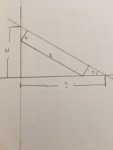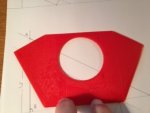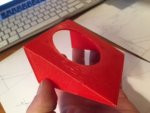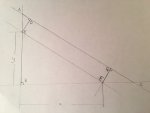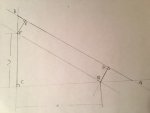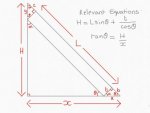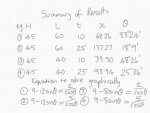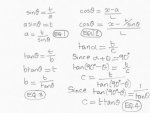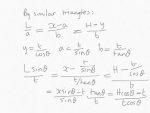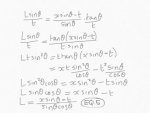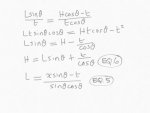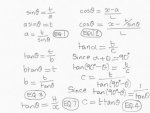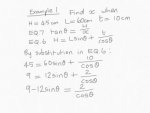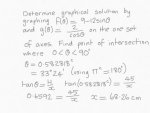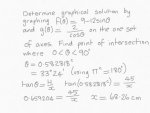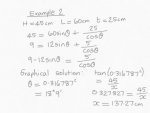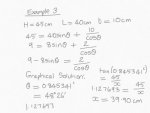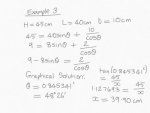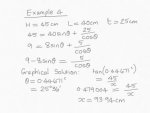Ok, I'll preface this by saying that I haven't had any geometry in about 40 years... 

Given H, L and t, I'm trying to find the length or angle noted with '?'.
As background, I need to mount a small fan that is t thick and L long, at such an angle that the bottom surface of a plate that that the fan is mounted to meets a vertical surface at height H, and such that the lower corners of the fan rest against the vertical surface and the horizontal surface (this would be the minimum-sized configuration). The thickness and length of the fan are variable (I know the value of each in advance, but I need to be able to substitute in different fan sizes and get the correct unknown length or angle), and the H height is a constant.
To further clarify (or muddy) things, consider the intersection of the line representing the plate, and the vertical surface, to be hinged at point H. A longer, or thicker, fan, would cause the far/lower end of the plate/line to change position on the X axis (as the two lower points of the fan will always need to contact the vertical and horizontal surface), as well as cause the vertical position of the fan lower corner's intersection with the vertical face to change. As I'm worried about the bottom surface of the plate, I'm ignoring the plate's thickness - a line should adequately represent the under side.
My intuition is telling me that this is a system of equations with 2 (?) unknowns, based on some geometry that Pythagoras and the Law of Sines might have some bearing on, but my rusty mind is having trouble piecing it together coherently.
I'm as much interested in the approach to the problem (more so, probably...) than the specific answer!
Given H, L and t, I'm trying to find the length or angle noted with '?'.
As background, I need to mount a small fan that is t thick and L long, at such an angle that the bottom surface of a plate that that the fan is mounted to meets a vertical surface at height H, and such that the lower corners of the fan rest against the vertical surface and the horizontal surface (this would be the minimum-sized configuration). The thickness and length of the fan are variable (I know the value of each in advance, but I need to be able to substitute in different fan sizes and get the correct unknown length or angle), and the H height is a constant.
To further clarify (or muddy) things, consider the intersection of the line representing the plate, and the vertical surface, to be hinged at point H. A longer, or thicker, fan, would cause the far/lower end of the plate/line to change position on the X axis (as the two lower points of the fan will always need to contact the vertical and horizontal surface), as well as cause the vertical position of the fan lower corner's intersection with the vertical face to change. As I'm worried about the bottom surface of the plate, I'm ignoring the plate's thickness - a line should adequately represent the under side.
My intuition is telling me that this is a system of equations with 2 (?) unknowns, based on some geometry that Pythagoras and the Law of Sines might have some bearing on, but my rusty mind is having trouble piecing it together coherently.
I'm as much interested in the approach to the problem (more so, probably...) than the specific answer!
Attachments
Last edited:

